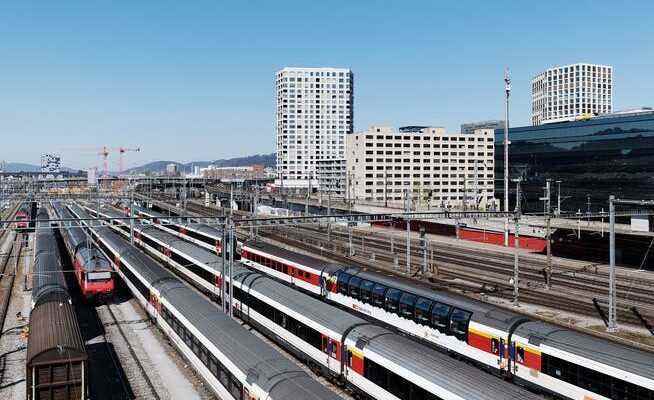Because of the corona pandemic, the federal railways severely restricted their offer in 2020. The industry is now preparing for the next crisis with scenarios.
During the reduced Corona timetable 2020, the SBB had to shut down numerous train compositions (pictured near Zurich Hardbrücke).
The adjustment of the timetable was drastic – and took place within a few days. In March 2020, SBB and the other transport companies gradually reduced their offer. The industry was thus reacting to the tightened measures taken by the Federal Council due to the corona pandemic. Long-distance trains only ran every hour instead of every half hour. There was also a limited offer in regional and S-Bahn traffic: on the routes where the quarter-hourly service applied, a train still ran every half hour; where the half-hourly clock applied, still every hour.
Many a passenger may have already forgotten the time when ghost trains drove through Switzerland – and the train staff no longer checked the tickets. But with the next looming crisis, a reduced timetable will become an issue again. In view of a power shortage in the coming winter, the SBB are developing emergency concepts for passenger and freight traffic with the federal government and the industry. The authorities have asked large consumers to prepare for a bottleneck.
What such a scenario could look like was recently described in a blog post by the German Shipping Industry Association (VAP). It brings together important rail customers such as Coop and Holcim as well as logisticians such as Planzer and Bärtschi. The VAP writes that passenger transport is based on the reduced timetables that it had already developed and implemented in the 2020 pandemic year. This should reduce energy consumption in the event of a crisis. In freight transport, possible scenarios would be developed with the logistics industry by the end of the year. The railway is systemically important for the national supply.
adjust temperatures
The SBB are only reluctant to comment on the subject. When asked, they emphasize that they have not yet made any decisions and have not decided on any scenarios. The SBB is currently reviewing all options, says spokeswoman Jeannine Egi – from a reduced timetable to adjusted temperatures in the trains to the neon signs.
SBB is the so-called system leader in rail transport. In the event of a crisis, they take measures that apply to the entire industry in consultation with the Federal Office of Transport (FOT). The federal government orders regional transport with the cantons. In long-distance traffic, he grants the SBB a license for several years and defines principles.
In order to prepare for a power shortage, the federal railways have put together a working group consisting of around ten people, according to Blick. She deals intensively with the energy situation and reports regularly to the group management, says Jeannine Egi. The working group also ensures coordination with the federal government.
Own hydroelectric power plants
SBB gets 90 percent of its traction power from hydroelectric power. You have several of your own power stations, including in Amsteg, Ritom and Vernayaz, but you also have a stake in the Nant de Drance pumped storage power station. In addition, the federal railways have procurement contracts with partner plants.
Despite the company’s own production, a power shortage would have consequences for the high-tech railway operations. In addition to the traction current, the SBB also need household electricity for the railway technology – for example for signals or signal boxes – which has a different voltage. Ultimately, it also depends on which priorities the federal government sets, according to Egi.
The Federal Office for Civil Protection considers a severe power shortage to be the greatest risk for Switzerland, even before an influenza pandemic or the failure of mobile communications. It is about a prolonged undersupply of electricity during the winter. During the cold season, Switzerland is dependent on imports from neighboring countries. However, there is a great risk that these countries will not produce enough electricity themselves to be able to export.
